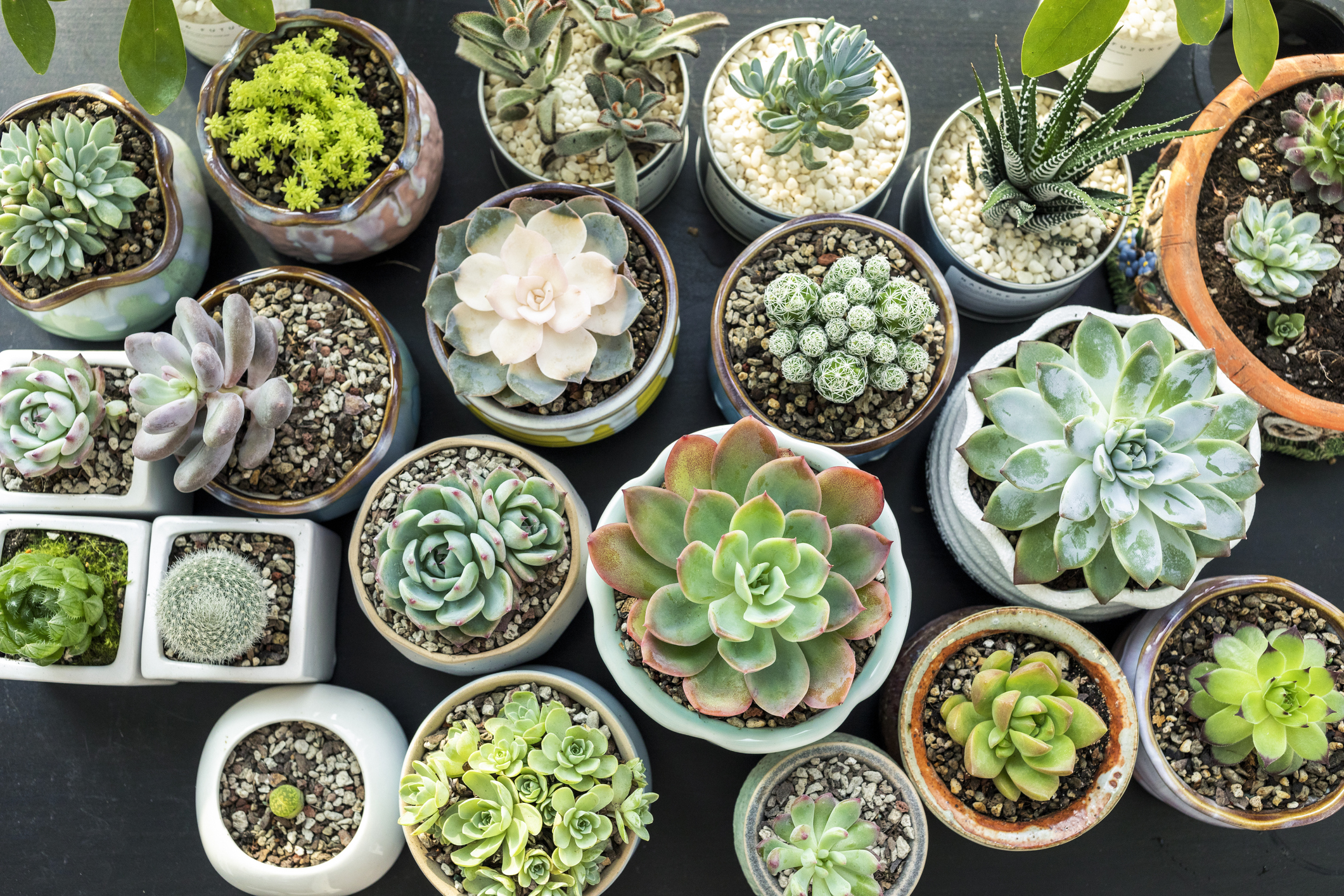How to care for succulents in winter
Know how to care for succulents in winter to enjoy these architectural plants right through to summer and beyond


Knowing how to care for succulents in winter will help these eye-catching plants survive changes in temperature and humidity.
These plants can of course grow all year round, but knowing how to care for succulents differs wildly from season to season. Here, we are dealing with winter succulents. Some succulents can tolerate very cold weather, making them great winter garden ideas. However, others are tender and need more careful treatment.
Whether you're winterizing succulents usually kept outdoors in a dry garden or want to find out how to care for house plants in winter to help succulents cope with the dry atmosphere caused by home heating, these expert tips will allow you to take good care of yours.
How to care for succulents in winter
Succulents are known for being drought-tolerant – and for hating being over-watered – but it isn't widely known that some succulents – often called 'hard succulents' can tolerate – and, in fact, thrive in very cold weather, making them some of the best winter plants for pots and borders. Other succulents, called 'soft succulents' will not survive temperatures below freezing and must be brought indoors.
Winter is perhaps the most common season to ask yourself, 'why is my succulent dying?' and all for a good reason. In these months, it is important to change your plant-care routine to avoid overwatering. Here's what you need to know about caring for succulents over winter, and how it changes, depending on their type.
Which succulents can stay outside in winter?
Hardy succulents, such as sedum, euphorbias, sempervivum, can tolerate temperatures as low as -20ºF. Always check the label when buying a plant to ensure it will suit temperatures in your zone.
Tender succulents, such as aloe, prefer clement weather, so either need to live indoors, where they prefer a room temperature of around 50ºF, or outdoors if the temperature never reaches freezing – even a light frost can damage tender leaves. If left outdoors, they will need frost protection.
Why can't some succulents tolerate freezing temperatures? The answer down to the amount of water they store in their leaves and stems (hence their drought-tolerance). This will freeze in cold weather, expand and damage the plant. The best route to success? Choose hard succulents over tender ones for outdoors if the zone you live in is subject to severe frosts, or be prepared to bring them in or protect them.
1. Winterize succulents by moving them
The best way to winterize succulents is by protecting them from freezing temperatures as succulents can't survive frost. You can do this by bringing them indoors, moving them to a covered porch, into a sunny spot – they love light – next to a sheltered wall, into a greenhouse or conservatory. Do this in fall or before temperatures get below 5ºF. For those succulents that have to remain outside, you can protect them in various ways.
2. Raise succulents off the ground in winter
If your succulents are in containers, and whether you've moved them to a sheltered spot or not, if they are still outside, raising off the freezing ground will help to protect their roots and leaves from ground frost.
3. Remove dead leaves
Before take any more steps to care for your winter succulents, do some pruning. An important way to care for succulents in winter is to remove dead or dying/damaged leaves. Leaving them on can cause rot to spread.
4. Protect succulents outdoors with fleece
Caring for succulents in winter does require some work. One way to protect them from freezing weather is with a heavy horticultural fleece. Wrap your succulents in fleece in late fall/early winter and you will protect them not just from cold but from really wet weather, which can lead the leaves to rot, especially if any have existing damage. The upside of horticultural fleece over other materials is that it will allow air to circulate around the succulents and light to filter through, helping to keep the plants happy.
5. Add a layer of gravel around the succulents' roots
While you might protect other winter plants with mulch, succulents planted in a border or in containers will benefit from a good thick layer of gravel or pebbles. These will, of course, provide some protection from frost, but will also stop your succulents' leaves from drooping into wet soil, which will increase the chance of rot infecting the plant.
6. Ensure succulent drainage is efficient
Succulents do not like to sit in water – after all, they are drought-tolerant. For this reason, it's important to ensure that succulent containers drain efficiently – especially in winter when any water left in the bottom of the container is likely to freeze.
Should I feed succulents in winter?
No, you should not feed succulents in winter. Feeding them will encourage growth when what you want them to do is to concentrate their energies on becoming hardier. Begin feeding again in warmer weather.
Should I water succulents in winter?
Knowing when to water succulents can make or break your success with these plants. Outdoors, succulents will be unlikely to need watering in winter. Indoors, limit watering to once a month, max. When watering succulents, always ensure the roots are soaked, but that the water in the plant's pot is able to immediately drain out. Succulents do not like their roots sitting in water.
Does leaf loss mean my succulents are dying in winter?
Leaf loss does not mean your succulent is necessarily dying – outer leaves often fall off in winter and this is not something to worry about. If, however, new growth is dying, you should be worried. It's likely this is being caused – as it often is with plants – by over-watering or over-feeding; if you catch it early enough, you will be able to save the plant.
Do succulents survive winter indoors?
Yes, succulents can survive indoors in winter but there are some steps you should take to guarantee plant health – with many of these succulent care tips worth doing anyway in winter.
Check your succulent is pest-free: you don't want to bring pests indoors, so check your plant's health and treat accordingly.
Tidy the plant: remove dead, dying or damaged leaves, weed around the succulent's roots. This isn't just about aesthetics – just as you don't want pests to spread to other house plants, you don't want weeds to either.
Provide drainage: just because it is warmer and drier indoors that out, it's still important to ensure that the succulents roots aren't sat in water, so ensure the containers have good drainage.
Stop watering succulents indoors in winter: you can allow the soil to dry out, then water very sparingly – they can be kept just on the wet side of dehydration.
Put succulents in a bright spot: succulents like sunlight so put them in a bright spot away from drafts.
Get the room temperature right: succulents like room temperatures of around 50ºF and 60ºF.
Sign up to the Homes & Gardens newsletter
Design expertise in your inbox – from inspiring decorating ideas and beautiful celebrity homes to practical gardening advice and shopping round-ups.

Lucy Searle has written about interiors, property and gardens since 1990, working her way around the interiors departments of women's magazines before switching to interiors-only titles in the mid-nineties. She was Associate Editor on Ideal Home, and Launch Editor of 4Homes magazine, before moving into digital in 2007, launching Channel 4's flagship website, Channel4.com/4homes. In 2018, Lucy took on the role of Global Editor in Chief for Realhomes.com, taking the site from a small magazine add-on to a global success. She was asked to repeat that success at Homes & Gardens, where she has also taken on the editorship of the magazine.
-
 Barack and Michelle Obama's neutral accent chair is the perfect living room focal point – you can recreate their serene style in any-sized home
Barack and Michelle Obama's neutral accent chair is the perfect living room focal point – you can recreate their serene style in any-sized homeThis designer-approved essential fits into every modern living room – it's beautiful enough to stand alone, while pairing well with your favorite cushion
By Megan Slack Published
-
 Should I choose a kitchen island or a kitchen table? This is the expert advice that helped me decide
Should I choose a kitchen island or a kitchen table? This is the expert advice that helped me decideIt's all about how you use your space
By Molly Malsom Published